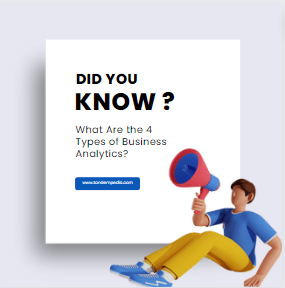What Are the 4 Types of Business Analytics?
Tandem Pedia - In today's fast-paced business world, data has become an essential part of decision-making.
 |
| What Are the 4 Types of Business Analytics |
Business analytics is the process of using data to identify trends, patterns, and insights that can help companies make informed decisions.
Four Types of Business Analytics
In this article, we'll explore the four types of business analytics and how they can benefit organizations.
1. Introduction
Business analytics is the practice of examining data to extract insights and gain understanding of business performance. It helps companies make data-driven decisions and optimize their business processes. There are four types of business analytics, each with its own approach and benefits. Let's dive into each type and explore their uses.
2. Descriptive Analytics
Descriptive analytics is the simplest form of business analytics. It focuses on summarizing past data to provide insights into what has happened in the past. Descriptive analytics answers the question "What happened?" and provides an overview of historical performance. This type of analytics is useful for identifying trends and patterns, such as sales trends or customer behavior.
3. Diagnostic Analytics
Diagnostic analytics is the next level of business analytics. It helps answer the question "Why did it happen?" by examining past data to identify the root cause of an issue or problem. This type of analytics is useful for identifying the factors that drive business performance, such as which marketing campaigns are most effective or which products are driving sales.
4. Predictive Analytics
Predictive analytics takes business analytics to the next level by forecasting future events or trends. It uses statistical models and machine learning algorithms to analyze historical data and identify patterns that can be used to make predictions about future performance. Predictive analytics is useful for forecasting demand, predicting customer behavior, and identifying potential risks.
5. Prescriptive Analytics
Prescriptive analytics is the most advanced form of business analytics. It not only predicts future outcomes but also suggests the best course of action to achieve the desired outcome. Prescriptive analytics is useful for optimizing business processes and making data-driven decisions in real-time. It uses machine learning algorithms and optimization techniques to suggest the best course of action for a given situation.
6. Advantages of Business Analytics
Business analytics provides a number of advantages for organizations. Some of the key benefits include:
- Better decision-making: By using data to inform decision-making, companies can make better-informed decisions that are based on real insights and data rather than intuition or guesswork.
- Increased efficiency: By analyzing business processes and identifying areas for improvement, companies can optimize their operations and become more efficient.
- Improved customer experience: By analyzing customer data, companies can identify patterns and insights that can be used to improve the customer experience, such as personalization or targeted marketing.
- Competitive advantage: By using data to gain insights into market trends and customer behavior, companies can gain a competitive advantage over their rivals.
7. Challenges of Business Analytics
While there are many benefits to using business analytics, there are also some challenges that organizations face. Some of the key challenges include:
- Data quality: Business analytics relies on high-quality data. If the data is incomplete, inaccurate, or inconsistent, it can lead to incorrect insights and decisions.
- Skills gap: Business analytics requires specialized skills such as data analysis, statistics, and programming. Many organizations struggle to find employees with the necessary skills.
- Cost: Implementing a business analytics program can be expensive, especially for small or mid-sized businesses.
- Change management: Implementing a data-driven culture can be a challenge.
8. Conclusion
9. FAQs
What is the difference between business intelligence and business analytics?
What types of data are used in business analytics?
What are some common business analytics tools?
How can organizations ensure data quality in their business analytics program?
How can organizations overcome the skills gap in business analytics?

Harga : *Belum termasuk Ongkos kirim